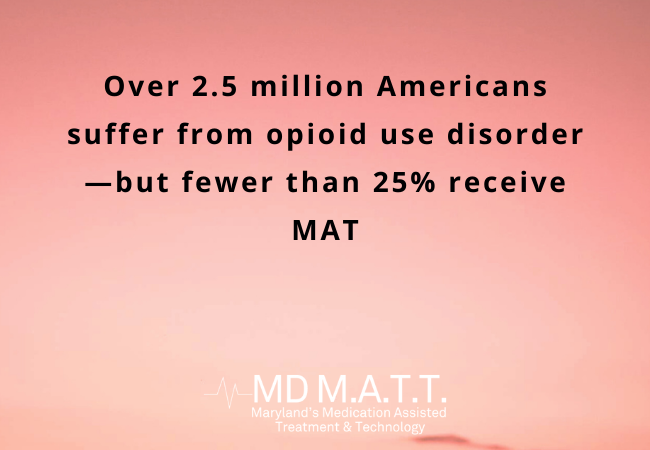The opioid crisis continues to claim lives at an alarming rate—and yet, one of the most effective, life-saving treatments available is still misunderstood and stigmatized. Medication-Assisted Treatment (MAT) has been clinically proven to reduce opioid use, lower overdose deaths, and help individuals achieve long-term recovery. Despite the overwhelming evidence, myths about MAT persist.
At MD M.A.T.T., a leading Medication-Assisted Treatment Center in Maryland, we’ve helped hundreds of individuals overcome addiction through evidence-based care—and we hear the same misconceptions over and over again. In this article, we address these myths head-on to give you clarity, confidence, and hope.
Whether you’re seeking treatment for yourself or a loved one—or just want to understand MAT better—this guide will provide the facts you need to make informed decisions.
What Is Medication-Assisted Treatment (MAT)? A Quick Refresher
MAT is a comprehensive approach to treating substance use disorders—especially opioid use disorder (OUD)—that combines:
- FDA-approved medications (like Suboxone, Methadone, or Naltrexone)
- Behavioral therapy and counseling
- Long-term support services
Unlike abstinence-only models, MAT treats addiction as a chronic, relapsing medical condition, not a moral failure. This method restores brain chemistry, reduces cravings, and enables individuals to focus on building a stable, sober life.
At MD M.A.T.T., we specialize in Suboxone-based care at our dedicated Suboxone Treatment Clinic in Maryland, along with counseling, mental health support, and relapse prevention planning.
Myth #1: “MAT Is Just Substituting One Addiction for Another”
The Truth: MAT manages a medical condition with medically supervised treatment—just like insulin for diabetes.
This is one of the most harmful and deeply rooted myths. Medications like Suboxone are not about getting high—they’re about restoring brain balance disrupted by prolonged opioid use.
- Buprenorphine in Suboxone binds to opioid receptors without producing euphoria.
- Naloxone blocks the effect of opioids and discourages misuse.
When used under the care of a licensed provider, Suboxone allows individuals to function normally—holding jobs, raising families, and rebuilding lives.
Addiction is a disease. Treating it with medication doesn’t create a new addiction—it’s an essential part of recovery.
Myth #2: “People on MAT Aren’t Really in Recovery”
The Truth: Recovery is about rebuilding your life, not proving abstinence.
Let’s be clear: abstinence is not the only definition of recovery. In fact, insisting that “real recovery” excludes MAT only increases shame, prevents people from seeking help, and drives overdose rates higher.
MAT is endorsed by:
- The National Institute on Drug Abuse (NIDA)
- The Substance Abuse and Mental Health Services Administration (SAMHSA)
- The American Medical Association
Patients on MAT who engage in therapy and build healthier lives are in recovery. Full stop.
Studies show that MAT participants have higher retention rates, lower relapse rates, and better long-term health outcomes than those using abstinence-only approaches.
Myth #3: “MAT Should Only Be Used as a Last Resort”
The Truth: MAT is often the most effective first step—not the last.
Many individuals mistakenly believe that MAT is for people who have “failed” at rehab or abstinence. But MAT isn’t a fallback plan—it’s an evidence-based first-line treatment.
- Relapse after detox is most likely within the first 90 days.
- MAT helps prevent relapse by relieving withdrawal and reducing cravings during that vulnerable early phase.
- People who start MAT early have a significantly greater chance of long-term recovery.
Waiting to use MAT can increase the risk of overdose, hospitalization, and death. Early intervention saves lives.
Myth #4: “You Shouldn’t Stay on MAT for Too Long”
The Truth: Recovery timelines are personal—and longer treatment is often more effective.
There is no “one-size-fits-all” timeline for MAT. Some people use Suboxone for 6 months. Others benefit from multi-year or long-term treatment—especially those with chronic relapse or co-occurring disorders.
- NIDA recommends at least 12 months on MAT for optimal results.
- Tapering off is done gradually and with support, based on progress—not pressure.
At MD M.A.T.T., we work with each patient to develop a timeline that fits their needs, with the option to taper when they’re clinically and emotionally ready.
There’s no shame in staying on a medication that keeps you healthy and sober.
Myth #5: “Suboxone Is Easily Abused”
The Truth: Suboxone has built-in protections and a low potential for misuse.
While all opioids carry some misuse risk, Suboxone is uniquely designed to minimize abuse:
- Naloxone prevents euphoric effects when injected.
- Buprenorphine’s ceiling effect reduces overdose risk.
- Suboxone produces no “high” when taken as prescribed.
At our Suboxone Treatment Clinic in Maryland, doses are carefully prescribed and monitored, and patients are supported through structured treatment, making misuse unlikely.
In fact, Suboxone is one of the safest opioid addiction treatments currently available.

Myth #6: “MAT Doesn’t Treat the Root Cause of Addiction”
The Truth: MAT is part of a comprehensive treatment plan that addresses both biological and psychological causes.
MAT is not just a medication—it’s a complete program that includes:
- Therapy to process trauma, mental health challenges, and behavioral patterns
- Group support to foster connection and accountability
- Life skills coaching and relapse prevention
- Peer and family counseling
At MD M.A.T.T., we integrate MAT with robust Addiction Treatment Services in Maryland, helping patients rebuild from the inside out.
Treating addiction means treating the whole person. MAT is a key piece of that puzzle.
Myth #7: “Quitting Cold Turkey Is Stronger Than Using Medication”
The Truth: There is nothing weak about choosing a medically sound, safer way to heal.
Quitting opioids without medical help is not only incredibly difficult—it can be dangerous. Withdrawal symptoms can be agonizing, and the risk of relapse is extremely high. Most overdoses happen after a period of abstinence when tolerance has decreased.
MAT helps:
- Reduce cravings
- Stabilize brain function
- Prevent fatal overdoses
- Improve quality of life
Strength isn’t about suffering through withdrawal. Strength is knowing when to seek help—and taking it.
Why Choose MD M.A.T.T. for Medication-Assisted Treatment in Maryland?
At MD M.A.T.T., we offer compassionate, confidential, and effective care through our full-service Medication-Assisted Treatment Center in Maryland. Our services include:
- Customized Suboxone treatment plans
- Behavioral health therapy
- Dual diagnosis support
- Telehealth and flexible scheduling
- Respectful, judgment-free environment
We’re not just treating addiction—we’re helping people rebuild their lives.
Conclusion
Don’t let stigma or misinformation stop you from getting the help you deserve. Medication-Assisted Treatment works. And at MD M.A.T.T., we’re here to prove it.
Medication-Assisted Treatment is not a shortcut, a crutch, or a substitute for real recovery—it’s a proven, life-saving path supported by science and success stories across the country.
If you’re ready to take the first step toward healing, MD M.A.T.T. is here to walk that journey with you. Call 410.364.8194 today to schedule your confidential consultation. Your recovery is real. Your path is valid. And the truth is: MAT works.
FAQ on Common Myths About MAT
Is Medication-Assisted Treatment (MAT) just substituting one drug for another?
No. MAT uses FDA-approved medications like Suboxone to stabilize brain function, reduce cravings, and allow individuals to focus on therapy and recovery. These medications are not euphoric and are carefully monitored by medical professionals.
Can you be in “real” recovery while on Suboxone or MAT?
Yes. Recovery is about improving your health and life—not about strict abstinence. Suboxone supports long-term recovery by reducing relapse risk and allowing individuals to live full, functional lives.
Is MAT only for people who failed rehab or can’t quit “the hard way”?
Not at all. MAT is a first-line treatment for opioid use disorder recommended by the CDC and SAMHSA. Starting MAT early can dramatically improve outcomes and reduce the risk of fatal overdose.
Shouldn’t MAT be short-term only?
There’s no one-size-fits-all timeline. Some patients taper after a few months, while others benefit from long-term or indefinite maintenance. MAT length is tailored to the individual’s needs and recovery goals.
Is Suboxone highly addictive or easy to misuse?
No. Suboxone has built-in safety features like a ceiling effect and naloxone to prevent misuse. When taken as prescribed, it has a low potential for abuse and is very effective in treating opioid addiction.
Does MAT ignore the root causes of addiction?
Absolutely not. MAT works best when combined with therapy. At MD M.A.T.T., we offer integrated care that includes behavioral health counseling, trauma therapy, and relapse prevention alongside medication.
Is quitting “cold turkey” better than using medication?
Quitting cold turkey can be dangerous and leads to high relapse rates. MAT provides a safer, more sustainable way to recover with reduced risk of overdose and improved long-term success.



